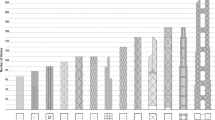Abstract
The 78 m Arts Tower at the University of Sheffield was refurbished during the period 2009–2011, with improvements that included replacement of façades and partitions. The structural changes were reflected in changes in dynamic properties that were tracked by a combination of long-term acceleration monitoring and vibration tests to identify local and global vibration modes. The global horizontal plane modes of the building were correlated with finite element model simulations and real-time automated operational modal analysis to characterize the effects of the structural changes on horizontal vibration modes in sway and torsion. In addition, floor vibration tests linked to the finite element simulations identified the contribution of ‘non-structural partitions’ on the floor dynamic performance. Replacement of heavy masonry partitions with modern lightweight forms has resulted in reduction of stiffness, yet there is no obvious change in sway vibration serviceability and floor performance remains satisfactory.




















Similar content being viewed by others
References
Alskif A (2011) The effect of non-structural partitions on the dynamic properties of the slab in Arts Tower. MSc Thesis, University of Sheffield
Basagiannis C (2011) Effect of non structural partitions on sway (vibration) performance of university Arts Tower. MSc Thesis, University of Sheffield
Building Research Establishment (1978) The dynamic behaviour of the Arts Tower, University of Sheffield and its implication to wind loading and occupant reaction. CP 48/78
Brownjohn JMW (2003) Ambient vibration studies for system identification of tall buildings. Earthq Eng Struct Dynam 32(1):71–95
Brownjohn JMW, Hao H, Pan T-C (2001) Assessment of structural condition of bridges by dynamic measurements. Applied Research Report 5/97, Nanyang Technological University, Singapore
Brownjohn JMW, Pan T-C, Deng XY (2004) Correlating dynamic characteristic from field measurements and numerical analysis of a high-rise building. Earthq. Eng Struct Dynam 29(4):523–543
Falati S (1999) The contribution of non-structural components to the overall dynamic behaviour of concrete floor slabs. D.Phil Thesis, University of Oxford
Littler JD (1988) Forced vibration tests on Sheffield University Arts Tower. In: Conference on civil engineering dynamics, University of Bristol, UK. Society for Earthquake and Civil Engineering Dynamics, pp 61–80
Miskovic Z, Pavic A, Reynolds P (2009) Effects of full-height nonstructural partitions on modal properties of two nominally identical building floors. Can J Civ Eng 36(7):1121–1132
Ngonda A (2009) Performance of high-frequency floors. MSc Thesis, University of Sheffield
Pan T-C, You X, Brownjohn JMW (2006) Effects of infill walls and floor diaphragms on the dynamic characteristics of a narrow-rectangle building. Earthq Eng Struct Dynam 35(5):637–651
Peeters B, De Roeck G (1999) Reference-Based Stochastic Subspace Identification For Output-Only Modal Analysis. Mech Syst Signal Process 13(6):855–878
Setareh M (2010) Vibration serviceability of a building floor structure. I: dynamic testing and computer modelling. ASCE J Perform Constr Facil 24(6):497–507
Stewart JP et al (2005) Field testing capabilities of the NEES@UCLE equipment site for soil-structure interaction applications. In: Geo-Frontiers, Austin, Texas, USA, pp 1–9
Su RKL et al (2005) Influence of non-structural components on lateral stiffness of tall buildings. Struct Des Tall Spec Build 14(2):143–164
Acknowledgments
Thanks to Paul Turner of University of Sheffield Estates Department for helping us through the logistical difficulties of access and asbestos and providing structural information, to Matthew Smith of Strainstall for providing sample data from their monitoring system, to Stuart Padgett of Gifford for providing details of the retrofit and of their performance predictions and to Chris Middleton for help with floor testing.
Author information
Authors and Affiliations
Corresponding author
Rights and permissions
About this article
Cite this article
Brownjohn, J., Koo, KY., Basagiannis, C. et al. Vibration monitoring and condition assessment of the University of Sheffield Arts Tower during retrofit. J Civil Struct Health Monit 3, 153–168 (2013). https://doi.org/10.1007/s13349-012-0028-x
Received:
Revised:
Accepted:
Published:
Issue Date:
DOI: https://doi.org/10.1007/s13349-012-0028-x




